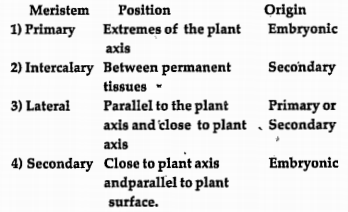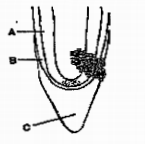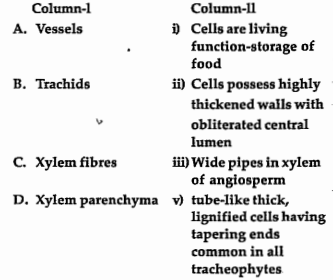Complete Solutions to EXERCISE of chapter PLANT TISSUE AND ANATOMY of Class 11 book with complete answers and questions
| Class 11 | BIOLOGY |
| Chapter | PLANT TISSUE AND ANATOMY |
| NIKITA PUBLICATION | EXERCISE |
| Number Of Questions | 83 |
| Academic Year | 2023-24 |
The term 'meristem' was given by…….
01:35View SolutionThe group of young unspecilized cells having capacity of division is called as
03:19View SolutionWhat is the meaning of meristos
00:59View SolutionMeristematic cells have
02:43View SolutionThe meristematic cells are
01:39View SolutionThe pro, primary, secondary meristem classification on
02:25View SolutionWhich of the following meristem is called as embryonal or primordial meristem.... Which meristem forms primary permanent tissue of primary plant body...
01:52View SolutionThe examples of primary meristem are
02:29View SolutionWhich meristem is responsible for growth, elongation of organs, occurs at the tip of roots, shoots.... and meristem present at base of node, internode, base of leaf is………
02:36View SolutionThe meristem present between regions of permanent tissue and disappear to give rise permanent tissue
01:09View SolutionIntercalary meristem and apical meristems are responsible for Increase in…….
01:12View SolutionThe meristem occurs parallel to long axis of stem and root
01:17View SolutionWhich of the following is false statement about lateral meristem
02:01View SolutionChoose the correctly matched options:
 01:42View Solution
01:42View SolutionAll of the following are true except
02:51View SolutionStatement (A) The meristem that occursin the mature regions of roots and shoots of many plants is called the secondary or lateral meristem. (B) Fascicular cambium, interfascicular cambium and cork-cambium are examples of lateral meristems. (C) These are responsible for producing the secondary tissues.
01:44View SolutionSelect the option that correctly identifies the labeling A, B and C in the given figure showing section of root apical meristem
 03:46View Solution
03:46View SolutionRead the following statements regarding meristematic cells and select the correct ones. (i) Cells possess the ability to grow and divide.( ii) Cells have dense cytoplasm with prominent nucleus.(iii)Cells are without intercellular spaces. (iv) Vacuoles are either absent or smaller in size (v) The plastids are in proplastid stage and cells do not store reserve food material.
02:07View SolutionHow many of the following are examples of lateral meristem ? (Cork cambium, Intercalary meristem, Intrafascicular cambium, Interfascicular cambium, Apical meristem)
01:52View SolutionBoth apical meristems and intercalary meristems are________meristems.
00:53View SolutionWhich of the following tissues has dead cells with thick and lignified cell walls, having a few or numerous pits ?
01:27View Solution_______1____ tissues are of 3 types _____2 _____3 ______and _____4 _________. Cells of _______2 ____are living cells without inter-cellular spaces. These provide mechanical support. Cells of_ 3_ are generally isodiametric and form the major component of plants organs. Cells of___ 4____ possess lignified cell walls and are usually dead
04:13View SolutionIncrease in girth of the plant as a result of the activities of primary and secondary lateral meristems is called
01:16View SolutionSelect the incorrect pair out of the following.
01:42View SolutionWhich of the following features is unrelated to collenchyma in plants?
03:50View SolutionWhich is the characteristic feature of permanent tissue?
01:15View SolutionThe simple permanent tissue consist of
03:53View SolutionStatements (A) Parenchyma forms major component within organs. (B) The cells of the parenchyma are generally isodiametric. They may be spherical, oval, round, polygonal or elongated in shape. (C) Their walls are thin and made up of cellulose. They are loosely arranged and have intercellular spaces.
01:58View SolutionCells of parenchyma are characterized by presence of:
01:56View SolutionWhich of the following is most simple tissue in organs and primitive tissue present in all parts of plant
01:30View SolutionParenchyma cells having chloroplasts constitute
01:28View SolutionStarch is mainly manufactured by:
01:01View SolutionIn hydrophytes aerenchyma is type of parenchyma helps to …
01:37View SolutionIf fibre like elongated cells present in parenchyma it is called as
01:35View SolutionParenchyma differ from collenchymas in its:
01:20View SolutionA simple tissue with mechanical and physiological functions in a young dicotyledons plants
01:19View SolutionWhich of the following living cells give the mechanical support and strength to plants?
01:30View SolutionThe collenchymas shows the deposition of ...at the corners
01:39View SolutionCollenchyma is present in
02:18View SolutionWhich of the following is wrong?
04:18View SolutionVascular tissues of angiosperms differ from those of gymnosperms in
02:13View SolutionMatch Column-1 with Column-11 and select the correct option from the codes given below.
 02:01View Solution
02:01View SolutionThickening of cell wall, lignification and specialization for mechanical function are characteristics of :
00:56View SolutionThe cells of which tissue are living in beginning having protoplasm but dead,impermeablein later stage
03:17View SolutionSclereids are present in
02:28View SolutionFind the wrong match.
01:03View SolutionSclerenchyma consists of
01:27View SolutionThe sclereids are
01:28View SolutionFibres occurs in
03:18View SolutionWhy xylem and phloem are called as complex tissue
04:24View SolutionWood is common name for....
03:44View SolutionThe tracheids are most prominent ( 90-95%) in
01:09View SolutionAn elongated cell with tapering ends & main conducting elements in most of tracheophytes is termed
00:54View SolutionA tracheid is distinguished from a vessel element on the basis of
02:22View SolutionHydrome is the synonym to one of the following tissues
03:08View SolutionThe most advanced type of thickening is
03:12View SolutionWater conducting elements of Gymnosperms and primitive angiosperms are
02:19View SolutionWhich elements are present in all vascular plants?
02:03View SolutionThe main water conducting elements of higher angiosperms and few gymnosperm are
02:43View SolutionWhich of the following is false statement
04:20View SolutionVessels are present in
03:06View SolutionWhich of the following is true for vessels?
03:11View SolutionThe thickenings present in vessels & tracheids are
04:03View SolutionAmong the tracheids and vessels which are more evolved elements
04:11View SolutionWhich elements of xylem helps in conduction of water and minerals as well as mechanical support
01:04View SolutionThe elements of xylem helps in storage & living is
03:10View SolutionIdentify the false statement
03:18View SolutionRead the followingstatements... (A) When protoxylem towards centre and metaxylem periphery-endarch (B) In roots protoxylem towards periphery and metaxylem towards centre- exarch (C) In stem, protoxylem towards centre and metaxylem towards both outer & inner side mesearch D) Xylem fibre is wood fibre (E) The early formed xylem is called as protoxylem and later formed xylem is metaxylem
03:27View SolutionWhich of the following is true about xylem parenchyma
01:18View SolutionSecondary xylem is formed from... during…
02:39View SolutionThe balloon like outgrowth formed by xylem parenchyma into vessels are called as
01:32View SolutionStructures which develop from wood parenchyma block transportation of water and minerals by vessels are.
04:02View SolutionWhich of the following is present in both xylem and phloem
00:44View SolutionLongest vessel is of:
00:53View SolutionConducting part of phloem is also named as....
03:02View SolutionCompanion cells are seen associated with..... and controls the conduction of food
01:10View SolutionA living mature cell which lacks nucleus.
03:22View SolutionIn mature sieve tubes a carbohydrate is responsible for closing the sieve pores. Which is termed as
01:11View SolutionThe cell functionally associated with sieve tube only in angiosperm and connected by pit fields present between common longitudinal wall:
01:11View SolutionThe Chief conducting element in the phloem of angiosperm is
00:51View SolutionWhich of the following statement is true
01:09View SolutionIn phloem of gymnosperms
01:12View SolutionAll of the following statements is true except
03:21View Solution
EXERCISE questions and complete solutions for chapter PLANT TISSUE AND ANATOMY of NIKITA PUBLICATION of Class 11
